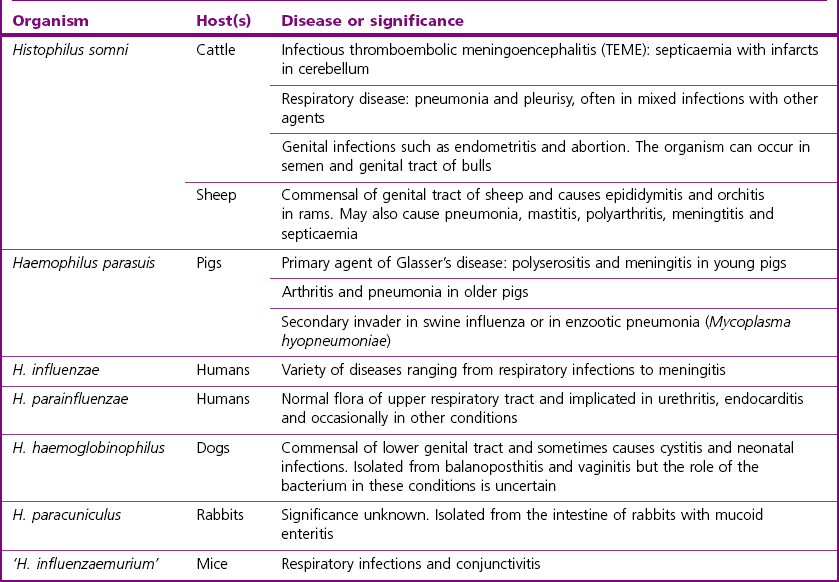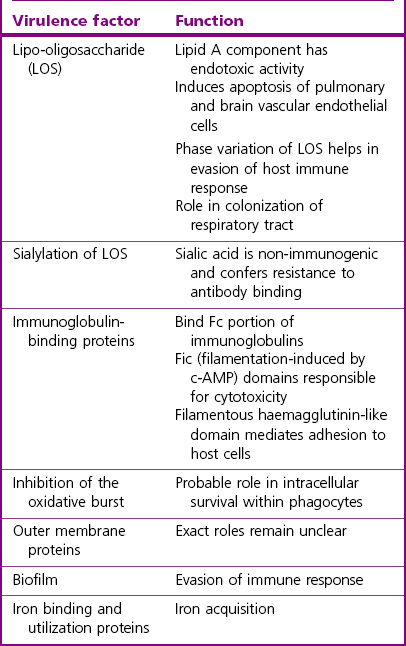Chapter 26 There have been a number of recent name changes to members of the Haemophilus genus. The species Histophilus somni now encompasses the organisms formerly known as Haemophilus somnus, Histophilus ovis and Histophilus agni. Haemophilus paragallinarum has been reassigned to the genus Avibacterium (see Chapter 21). Haemophilus piscium strains are included in the species Aeromonas salmonicida (see Chapter 19). Haemophilus and Histophilus species are small Gram-negative rods, less than 1 µm wide by 1–3 µm, but can be coccobacillary or produce short filaments. Capsules can be produced by H. influenzae and H. parasuis. Traditionally Haemophilus species had to have, by definition, an absolute requirement for one or both of the growth factors: X (haemin) that is heat-stable and V (nicotinamide adenine dinucleotide; NAD) that is heat-labile. However, Histophilus somni is able to grow in the absence of these factors although growth is enhanced by their presence. Haemophilus and Histophilus species are motile, facultative anaerobes, produce acid from glucose, reduce nitrates, and are variable in the oxidase and catalase tests. They are nutritionally fastidious, will not grow on MacConkey agar and grow best on chocolate agar (supplying the X and V factors) under 5–10% CO2 at 37°C. The most significant pathogens of these species are Haemophilus parasuis which causes Glasser’s disease in pigs and Histophilus somni which casuses a variety of conditions in domestic ruminants (Table 26.1). Even within the pathogenic species, there is a high level of strain variability; some strains appear to be avirulent whereas others are consistently isolated from pathological specimens and possess a range of virulence factors. Traditionally Haemophilus species are classified by serotyping. Unfortunately no clear relationship exists between serotype and pathogenicity although some serotypes such as H. parasuis, serotype 3, are isolated only from mucosae and never from systemic sites (Oliveira et al. 2003). Genetic characterization of these organisms has identified many putative virulence genes but in most cases the role of the virulence attributes has not been conclusively demonstrated in vivo. Histophilus somni is resistant to the lethal effects of phagocytes and serum, in part through the production of immunoglobulin-binding proteins which bind the Fc portion of bovine IgG. It can adhere to epithelium and is toxic to endothelial cells to which it also adheres. Immunoglobulin-binding proteins may mediate adherence to host cells and in addition, these proteins have two direct repeat regions which contain Fic (filamentation-induced by c-AMP) domains. These motifs mediate cyotoxicity through induction of cytoskeletal collapse (Worby et al. 2009). Infections of lungs, body cavities and joints are serofibrinous and/or suppurative. Thrombotic vasculitis leading to encephalitis and meningitis as well as haemorrhagic necrotizing processes are caused by H. somni. Young or previously unexposed animals are most susceptible to H. somni and Haemophilus infections with stress factors contributing to the development of signs of disease. Virulence attributes of Haemophilus parasuis are not well defined. In common with H. somni it produces lipo-oligosaccharide and a number of outer membrane proteins. Table 26.1 summarizes the diseases or significance of H. somni and Haemophilus species associated with animals, while virulence factors are summarized in Table 26.2.
Haemophilus and Histophilus species
Genus Characteristics
Pathogenesis
![]()
Stay updated, free articles. Join our Telegram channel

Full access? Get Clinical Tree


Veterian Key
Fastest Veterinary Medicine Insight Engine


